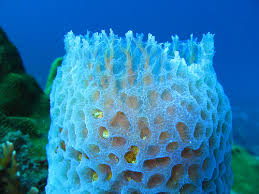Scientific classification: Sponges make up the phylum Porifera. Three major groups exist. All the Calcarea are marine, with skeletal spicules composed of calcium carbonate.
Introduction
Porifera constitute several thousand species constituting a phylum of simple invertebrate animals. porifera are mainly marine, with a few freshwater species. They are abundant throughout the world and especially in tropical waters, where they and other invertebrates such as corals are important in the formation of calcareous deposits.
Characteristics
The primitive cellular construction of sponges consists of an outer layer of covering cells and an inner layer of flagellated cells that move water through the animals. Between the two layers are numerous wandering, amoebalike cells and supporting skeletal structures, often in the form of hard, crystal-like spines called spicules. Sponges feed on fine particulate material by moving water into lateral incoming pores called ostia and then out a large topmost opening called the osculum. Each flagellated cell, or choanocyte, has a thin collar around a single flagellum. Choanocytes line either large chambers or small ones called flagellated chambers. If the latter are present, they are connected by canals, and the entire sponge can build up pressure and shoot water long distances from the osculum apparently a mechanism to avoid reuse of oxygen- and food-depleted water, phylum porifera. A recently discovered sponge from the Mediterranean Sea lacks the choanocytes and canals necessary to filter feed. Instead this carnivorous sponge passively traps, envelops, and digests crustaceans on its surface with a series of tiny hook-shaped filaments.
Reproduction
Reproduction occurs either sexually or asexually. In the former case, the sponges are usually hermaphroditic but cross-fertilize one another. Eggs and sperm unite to produce a free-swimming larva that settles on a new surface. Reproduction can also occur by small, internal asexual buds called gemules, phylum porifera each one able to give rise to a new sponge. Sponges have also been of great interest to developmental biologists because sponges are able to reconstitute themselves if their cells are separated into a suspension.
Marketable sponges
Six species of sponge are considered marketable, with numerous varieties. The skeleton of these sponges is composed only of spongin tissue and contains no hard spicules. The Mediterranean sponges are the softest and best; those of the Red Sea are next in quality, and the West Indian species are coarser and less durable. The sponges are gathered by divers, and the living tissue is allowed to decompose. The remaining undecomposed skeleton of spongin fibers is then washed, phylum porifera bleached, sometimes dyed, and cut into the familiar blocks seen on store counters.

